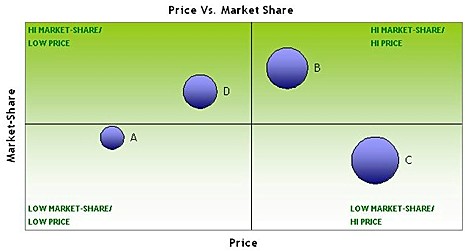Pricing is one of the 4 Ps of marketing and the most basic tactic, having been around for hundreds if not thousands of years. It is the most direct way of communicating value to customers and has the most direct impact on bottom-line performance.
At the same time, price as a marketing instrument is difficult to leverage effectively because it involves integrating decision-making vertically and horizontally within the organization. Apart from the bottom line, it can also impact brand perception: Too low a price may cause the brand to be perceived as a commodity, whereas too high a price runs risk of being priced out of the market.
Pricing has multiple levels of implementation. At the highest level is strategic pricing, which takes into account long-term profit objectives of the organization at brand or franchise level. The next layer is tactical pricing, which optimizes price to take into account short-term market dynamics, including demand shifts and competitive effects. The lowest layer is execution level, where SKU-level dynamics and inventory and supply management come into play.
If too much focus is placed on strategic pricing, short-term opportunities occurring due to competitive actions may be missed or aggressive campaigns may go unchallenged, leading to expensive market share loss, which may not easily be regained. On the other hand, a myopic focus on tactical pricing will miss the big picture, causing long-term loss of profitability.
Pricing optimization is the process by which revenue is optimized by maximizing buyers for minimum reduction in price, or maximizing price for a minimal loss of buyers. This is a tricky tradeoff, as under-pricing directly impacts the bottom line and over-pricing indirectly impacts market share.
Pricing relies on tried and tested concepts from economics, like demand-supply equilibrium and utility functions.
Pricing has greater leverage for products or brands with higher price elasticity, since small changes in pricing can result in substantial changes in revenue (Price elasticity is the percentage change in demand/revenues for a percentage change in price).
The effectiveness of pricing as marketing lever is also affected by competitive pricing activities, especially for brands and products with high cross-elasticities. Cross-elasticity is the percentage change in the demand for a product for a percentage change in the price of a competing product.
Pricing effectiveness is also affected by other marketing tactics, like promotions and advertising. If there are substantial changes over time in these tactics, the true impact of pricing strategies may be confounded with the results of those tactics. Pricing can then be correctly measured by controlling for these different drivers of demand, which is typically done through a market-response or marketing-mix model.
Tactical price optimization can be carried out with output from simple regression models that ignores the simultaneous competitive reaction for pricing changes, because in the short term the impact of these changes may be very subtle. But in models that simulate scenarios of strategic, longer-term price changes, not including the simultaneous relationship between brand and competitive pricing will lead to potentially spurious results, because the sales change from brand-level pricing change may partially be offset by competitive reactionary pricing.
Pricing has several business objectives, which can become the primary pricing strategy or may form a portfolio of pricing strategies that can be alternated to meet different market conditions:
- Profit maximization: This is pricing for maximum profit and can be pursued if the product is sufficiently differentiated in the market.
- Target ROI- or ROA-based pricing: Here price is simply Cost of Goods Sold + [target return times total investment or total assets].
- Market-share growth: For well-capitalized firms, a short-term offensive strategy may involve lowering price to almost break-even levels to increase market share. In addition to greater market share, which can be later leveraged to increase prices, this strategy also helps in increasing margins by lowering costs from the economies of scale achieved through higher volume.

The above matrix, which is an adaptation from the well-known BCG Matrix, shows pricing and market-share for four hypothetical brands:
- Brand A has a low price and low market share; it is a small player that will eventually either buckle under the pressure of the large volume players or get acquired.
- Brand B is the high-end market leader that enjoys a price premium—an enviable position to be in. This is not usually a sustainable position unless the player has a considerable competitive advantage that acts as a barrier to entry for other players.
- Brand C is the niche market player that enjoys a price premium, usually for the high-end segment of the market—a profitable but risky strategy due to a lack of diversification.
- Brand D is the high-volume price discount player (Wal-Mart, for example); it maintains its market position by keeping very low margins and making profits on volume.
This is just one of the ways in which pricing strategies can be related to sales growth. These broader strategies are further segmented into more sophisticated techniques like Hi-Lo retail pricing (alternatively pricing some items high in some weeks and low in other weeks to give an overall impression of being a low-price retailer).
Every Day Low Price (EDLP) is another popular strategy (a strategy of consistently offering a low price, but not the lowest). Other broader strategies are "skim pricing" (high price margins in an innovative or low-competition market) and "penetration pricing" (low price margins for the purpose of building initial market share).



